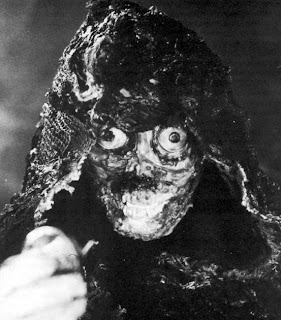SEVERANCE (2006)
THE COTTAGE (2008)
If only former BROOKSIDE actress Jennifer Ellison had remained gagged for THE COTTAGE’s entire running time…
THE COTTAGE (2008)
If only former BROOKSIDE actress Jennifer Ellison had remained gagged for THE COTTAGE’s entire running time…
TWO jet-black humoured horrors set within the backwoods, and made by second-time directors, SEVERANCE and THE COTTAGE will never approach the finesse of SHAUN OF THE DEAD in the comedy stakes; both are grimmer, more shocking, and considerably less amiable. SEVERANCE tells of seven Palisade Defence employees on a team-building weekend in Hungary: there's Steve (Danny Dyer) the laid-back stoner-slacker, Harris (Toby Stephens) the golden-boy sales champ, Gordon (Andy Nyman) the overly enthusiastic corporate pawn, Richard (Tim McInnerny) the odious upper-management tyrant (“I can’t spell success without u…”), Maggie (Laura Harris) the sex-object, Jill (Claudie Blakley) the practical-minded girl with glasses, and Billy (Babou Ceesay) the token black PA. When Jill spots a masked figure outside their run-down bunker, it is only the start of a fight against a group who have more than axes to grind.
Christopher Smith - who previously made the London Underground chiller CREEP - adds underlying themes of dubious arms trading and exploitation of Eastern Europe, but any such commentary is overwhelmed by the gallows humour, including an encounter with a bear trap and a severed head rolling away still reacting in surprise. It is a thoroughly entertaining piece of work with one standout comedy moment - the accidental blowing up of a passing plane by Palisade’s American boss George (David Gilliam) - and the dwindling survivors are characters who are up a fight, even though the gun-toting call girls are more Russ Meyer than survival horror.
Claudie Blakley shortly to become toast at the hands of the Flamethrower Killer - one of the many denizens haunting the backdrop of SEVERANCE.
Contrastingly, THE COTTAGE feels like a cheap cash-in. Writer/director Paul Andrew Williams - whose debut was the critically acclaimed LONDON TO BRIGHTON - unleashes a unrelentingly violent and uneven sophomore effort. Two brothers - David (Andy Serkis) and Peter (Reece Shearsmith) - kidnap nightclub owner’s daughter Tracey (Jennifer Ellison) and hold her ransom in a secluded country cottage. When her dim-witted step-brother Andrew (Steven O’Donnell) - who is in on the scam - delivers the ransom, they find out that not only have they been tricked, but Andrew has been followed by his father's bloodthirsty Korean henchman. As the blackmail spirals out of control, Tracey manages to turn the tables on her kidnappers and escapes with Peter as her hostage, fleeing into the woods; it isn’t long before everyone faces a desperate battle against a disfigured local farmer (Dave Legeno in see-the-join make-up).
Williams claims THE COTTAGE explores the bond between brothers, but while early scenes of Serkis and Shearsmith show potential, this quickly gets lost amid the director’s insatiable appetite for humour and gore. The brothers spend too much time bickering to endear themselves, and Ellison’s expletive-heavy Liverpudlian is every bit as monstrous as the main killer himself, resulting in a priceless understanding glance between the farmer and Peter. In a role written especially for Shearsmith, the LEAGUE OF GENTLEMAN star shines brightest of all; the butt of continual violence, and permanently bloody-nosed, the deadpan Royston Vasey-stalwart completely understands this undiluted strain of Amicus-like weirdness.





